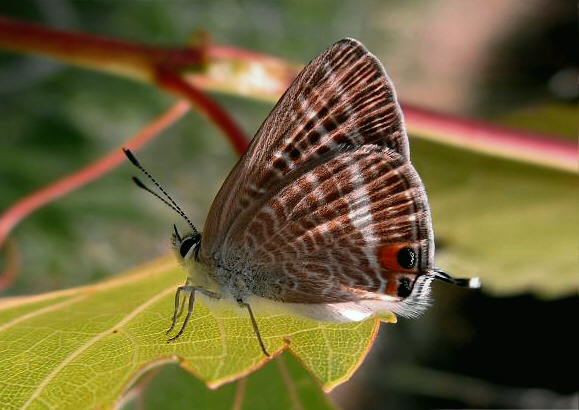 Lampides boeticus France – Graham Thompson
Lampides boeticus France – Graham Thompson
Introduction
The Long-tailed Blue, or Pea Blue as it is often called, is the sole member of the genus Lampides. Despite its small size and apparent fragility it is strongly migratory, able to cross seas, oceans and low mountain ranges with relative ease. It is one of the commonest and most widespread species in the Old World, breeding in southern Europe, almost throughout Africa, and across southern Asia to Indonesia and Australia, and reached New Zealand in 1965.
The butterfly reached Hawaii in 1882 but has not yet reached the Americas, although it will almost certainly manage to do so within a few years, probably as a result of being accidentally introduced with an imported plant.
Lampides boeticus is widespread and common in southern Europe where it produces several over-lapping broods. It occasionally reaches Britain, e.g. in September 2003 when it bred at Ranmore Common in Surrey.
On the upperside males are pale blue with narrow dark borders. Females are dark earthy brown, with a slight flush of pale blue scales at the base of the wings. The pattern on the underside is unique, so this species is unlikely to be confused with any other.
Habitats
In Europe the butterfly is found mainly in hot, dry flowery places, including waste ground and cultivated areas, always at low altitudes. It is commonest in the Mediterranean area, but breeds regularly as far north as central France and Germany. On the very rare occasions when it reaches Britain it is usually found on south-facing hillsides or coastal grasslands.
Lifecycle
The eggs are china-white and covered with a network of reticulations. They are laid on the flowers, sepals and flower stalks of herbs and bushes in the family Fabaceae. In Europe these include Colutea, Helianthemum, Lathyrus, Pisum, Phaseolus and Ulex.
The larvae when fully grown are cylindrical, and occur in several colour forms including dark green, yellowish green, and pearly white. All forms have a brown dorsal stripe, reddish lateral streaks and a brown head. The larva has a honey gland on the 7th abdominal segment which attracts certain ant species which milk it for the secretion. The presence of the ants is undoubtedly beneficial in providing a degree of protection against parasitoid wasps and flies. The larva is cannibalistic at all stages of its life, with the result that only one larva survives on each plant.
The smooth rounded chrysalis is creamy or pale brown, with a dark dorsal line. It is usually formed at ground level, attached to a dead leaf.
Adult behaviour
The migratory nature of the butterfly means that adults can be seen singly almost anywhere, but normally in the areas where it breeds several can be seen flying together around leguminous herbs and bushes. Both sexes nectar at a wide variety of wild and cultivated flowers.
The antennae-like “tails” on the hindwings, together with the orange, silver and black “eyespot” at the tornus act together to create the impression of a false head, and divert the attention of birds away from the body. When the butterfly first settles it immediately turns around, and when it is feeding it often walks about in tight circles, thus a predator is never quite sure which direction it is facing. It also oscillates its hindwings causing the tails to wiggle like antennae. This reinforces the back-to-front illusion, and probably causes attacking birds to aim at the tail instead of the head of the butterfly, enabling it to escape relatively unharmed, leaving the bird with nothing but a piece of detached wing in its beaks.
